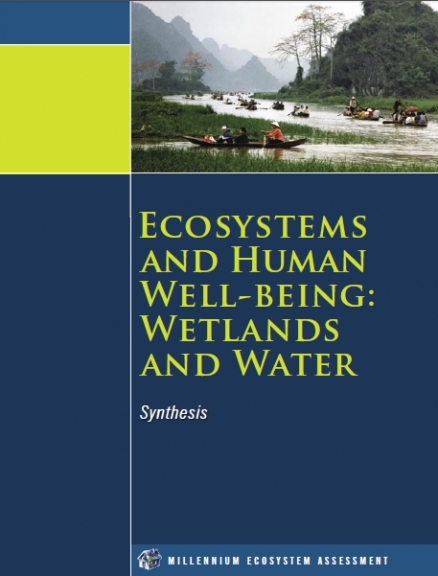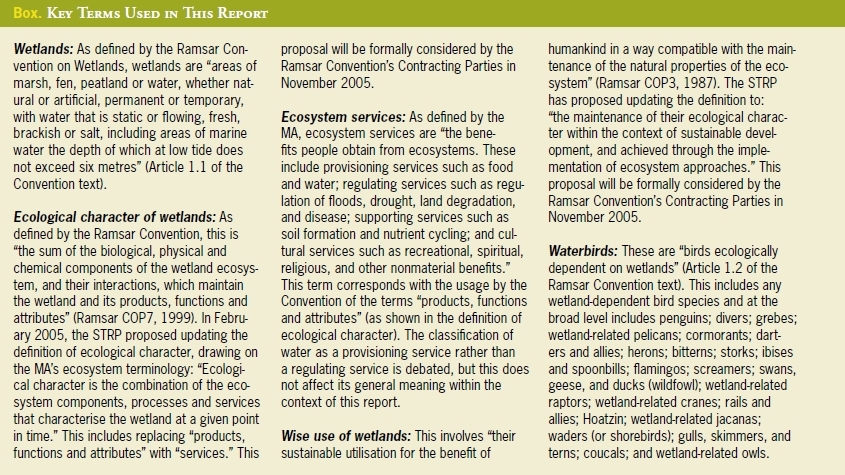Ecosystems and Human Well-being: Wetlands and Water: Readers Guide and Acknowledgments
This is part of the Millennium Ecosystem Assessment report Ecosystems and Human Well-being: Wetlands and Water.
Synthesis Team Co-chairs: C. Max Finlayson, Rebecca D’Cruz, Nick Davidson
Synthesis Team Members: Jacqueline Alder, Steve Cork, Rudolf de Groot, Christian Lévêque, G. Randy Milton, Garry Peterson, Dave Pritchard, Blake D. Ratner, Walter V. Reid, Carmen Revenga, María Rivera, Frederik Schutyser, Mark Siebentritt, Mishka Stuip, Rebecca Tharme
Contributing Authors: Stuart Butchart, Ellen Dieme-Amting, Habiba Gitay, Steve Raaymakers, Douglas Taylor
Extended Writing Team: MA Coordinating Lead Authors, Lead Authors, Contributing Authors, and Working Group Coordinators
Review Editors: José Sarukhán and Anne Whyte (Co-chairs) and MA Board of Review Editors
This report uses the Ramsar Convention definitions of several key terms related to wetlands. (See Box on Key Terms.) All of the MA authors and Review Editors have contributed to this draft through their contributions to the underlying assessment chapters on which this material is based.
Five additional synthesis reports were prepared for ease of use by other audiences: general overview, UNCCD (desertification), CBD (biodiversity), business, and the health sector. Each MA sub-global assessment will also produce additional reports to meet the needs of its own audience. The full technical assessment reports of the four MA Working Groups will be published in 2005 by Island Press. All printed materials of the assessment, along with core data and a glossary of terminology used in the technical reports, will be available on the Internet at www.MAweb.org. Appendix A lists the acronyms and abbreviations used in this report and includes additional information on sources for some of the Figures.
References that appear in parentheses in the body of this report are to the underlying chapters in the full technical assessment reports of each Working Group. (A list of the assessment report chapters is provided in Appendix B (Ecosystems and Human Well-being: Wetlands and Water: Readers Guide and Acknowledgments).) To assist the reader, citations to the technical volumes generally specify sections of chapters or specific Boxes, Tables, or Figures, based on final drafts of the chapter. Some chapter subsection numbers may change during final copyediting, however, after this report has been printed.
In this report, the following words have been used where appropriate to indicate judgmental estimates of certainty, based on the collective judgment of the authors, using the observational evidence, modeling results, and theory that they have examined: very certain (98% or greater probability), high certainty (85–98% probability), medium certainty (65–85% probability), low certainty (52–65% probability), and very uncertain (50–52% probability). In other instances, a qualitative scale to gauge the level of scientific understanding is used: well established, established but incomplete, competing explanations, and speculative. Each time these terms are used they appear in italics.
Throughout this report, dollar signs indicate U.S. dollars and tons mean metric tons.
This report would not have been possible without the extraordinary commitment of the more than 2,000 authors and reviewers worldwide who contributed their knowledge, creativity, time, and enthusiasm to the development of the assessment. Thanks are due to the MA Assessment Panel, Coordinating Lead Authors, Lead Authors, Contributing Authors, Board of Review Editors, Expert Reviewers, and the members of the Scientific and Technical Review Panel of the Ramsar Wetlands Convention who contributed to this process and to the institutions that provided in-kind support enabling their participation. The current and past members of the MA Board (and their alternates), the members of the MA Exploratory Steering Committee, the Convention on Wetlands secretariat staff, and the MA secretariat staff, interns, and volunteers all contributed significantly to the success of this process.
The MA received major financial support from the Global Environment Facility; United Nations Foundation; David and Lucile Packard Foundation; World Bank; Consultative Group on International Agricultural Research; United Nations Environment Programme; Government of China; Ministry of Foreign Affairs of the Government of Norway; Kingdom of Saudi Arabia; and the Swedish International Biodiversity Programme. The full list of organizations that provided financial support to the MA is available at www.MAweb.org.
Terms of Use
The copyright for material on this page is the property of the World Resources Institute. Click here for the Terms of Use (Ecosystems and Human Well-being: Wetlands and Water: Readers Guide and Acknowledgments).
Disclaimer: This chapter is taken wholly from, or contains information that was originally written for the Millennium Ecosystem Assessment as published by the World Resources Institute. The content has not been modified by the Encyclopedia of Earth.
|
|

